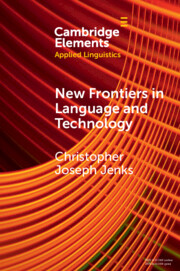Element contents
New Frontiers in Language and Technology
Published online by Cambridge University Press: 16 June 2023
Summary
Keywords
- Type
- Element
- Information
- Series: Elements in Applied LinguisticsOnline ISBN: 9781009184403Publisher: Cambridge University PressPrint publication: 13 July 2023
References
- 8
- Cited by

